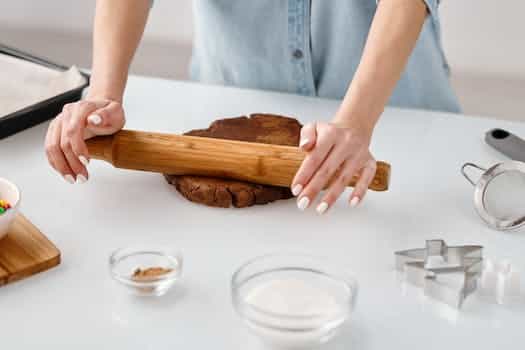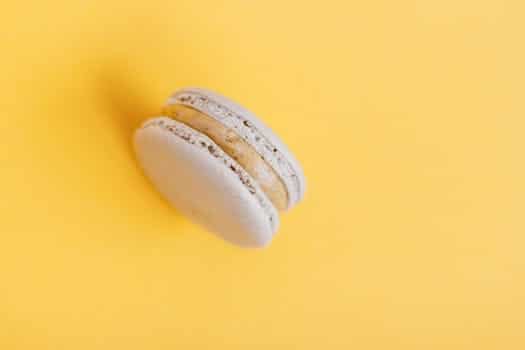In this article, we will explore a selection of delicious gluten-free dessert recipes that utilize flour substitutes. Whether you have a gluten intolerance or simply want to explore new baking options, these recipes provide a tasty and satisfying alternative. By using various flour substitutes, you can still enjoy mouthwatering desserts without compromising on taste or texture. Get ready to indulge in a world of gluten-free delights!
- 1. Introduction
- 1.1. What is gluten-free flour?
- 1.2. Benefits of gluten-free flour
- 1.3. Using gluten-free flour in dessert recipes
- 1.4. Tips for baking with gluten-free flour
- 1.5. Common types of gluten-free flour
- 2. Delicious gluten-free dessert recipes
- 2.1. Gluten-free chocolate chip cookies
- 2.2. Banana bread with gluten-free flour
- 2.3. Blueberry muffins using gluten-free flour
- 2.4. Vanilla cupcakes with gluten-free flour
- 2.5. Apple crumble made with gluten-free flour
- 3. Substituting gluten-free flour in traditional dessert recipes
1. Introduction
When it comes to satisfying your sweet tooth, being gluten-free doesn’t mean you have to miss out on delicious desserts. With the availability of various flour substitutes, you can still enjoy mouthwatering treats without the use of traditional wheat flour. Whether you have a gluten intolerance or simply choose to follow a gluten-free diet, these gluten-free dessert recipes will surely impress your taste buds. From decadent chocolate cakes to fruity pies, there are countless options for creating delectable gluten-free desserts. In this article, we will explore some delightful recipes that use flour substitutes, allowing you to indulge in guilt-free sweetness.
1.1. What is gluten-free flour?
Gluten-free flour is a type of flour that does not contain gluten, a protein found in wheat, barley, and rye. It is specifically designed for individuals who have gluten sensitivity, celiac disease, or choose to follow a gluten-free diet. Gluten is responsible for the elastic texture in traditional flour and helps baked goods to rise and hold their shape. However, for those with gluten intolerance, consuming gluten can lead to digestive issues, inflammation, and other health problems.
Gluten-free flour is typically made from alternative grains and starches such as rice, almond, coconut, tapioca, or potato. These substitutes provide similar properties to gluten, allowing individuals to still enjoy their favorite baked goods without the negative effects of gluten. It is important to note that different gluten-free flours have varying textures, flavors, and baking properties, so it may require some experimentation to achieve the desired results when substituting traditional flour with gluten-free alternatives.
In recent years, the demand for gluten-free products has increased significantly, leading to a wide variety of gluten-free flours available in the market. Whether you are a professional baker or a home cook, understanding the different types of gluten-free flour and how to use them can open up a world of possibilities for creating delicious gluten-free desserts.
1.2. Benefits of gluten-free flour
Gluten-free flour has gained popularity in recent years as more people are adopting gluten-free diets due to health reasons or personal preferences. This type of flour is made from grains or starches that do not contain gluten, a protein found in wheat and other grains. By using gluten-free flour substitutes in dessert recipes, individuals can enjoy delicious treats without the discomfort or adverse effects that gluten may cause. In this article, we will explore the benefits of using gluten-free flour in dessert recipes and provide some mouth-watering gluten-free dessert ideas.
1.3. Using gluten-free flour in dessert recipes
When it comes to creating delicious gluten-free desserts, using flour substitutes is a game-changer. Many people with gluten sensitivities or celiac disease often have to miss out on their favorite treats. However, with the availability of gluten-free flours, it is now possible to enjoy a wide variety of desserts without compromising on taste or texture.
Gluten-free flours are made from alternative grains and starches such as rice, almond, coconut, tapioca, or potato. These flours are free from gluten, a protein found in wheat, barley, and rye that can cause digestive issues for some individuals.
By using gluten-free flour substitutes in dessert recipes, you can create mouthwatering treats that are safe for those with gluten intolerances. Not only do these flours provide a suitable replacement for traditional wheat flour, but they also add unique flavors and textures to your desserts.
In this article, we will explore various gluten-free flours that can be used in dessert recipes. From classic chocolate chip cookies to fluffy pancakes, we will cover a range of delicious gluten-free dessert options that everyone can enjoy. So, get ready to satisfy your sweet tooth with these delectable gluten-free treats!
1.4. Tips for baking with gluten-free flour
Baking with gluten-free flour can be a bit different than using regular flour, but with the right tips and techniques, you can create delicious gluten-free desserts that everyone will love. Whether you have a gluten intolerance or simply want to explore new baking options, these tips will help you achieve great results. From choosing the right flour substitute to adjusting your recipes, here are some essential tips for baking with gluten-free flour:
1.5. Common types of gluten-free flour
There are several different types of gluten-free flour that can be used as substitutes in baking delicious desserts. These flours are a great option for those with gluten sensitivities or celiac disease, as they allow for the creation of tasty treats without the harmful effects of gluten. Here are some common types of gluten-free flour that you can use in your dessert recipes:
2. Delicious gluten-free dessert recipes
Are you tired of missing out on delicious desserts because of your gluten intolerance? Well, worry no more! With these amazing gluten-free dessert recipes, you can satisfy your sweet tooth without compromising your health. And the best part? These recipes use flour substitutes that are both nutritious and delicious. So, get ready to indulge in some mouthwatering gluten-free treats!
2.2. Banana bread with gluten-free flour
Banana bread is a classic and beloved dessert that can easily be made gluten-free by using an alternative flour. In this recipe, we will be using gluten-free flour to create a delicious and moist banana bread that everyone can enjoy. The gluten-free flour gives the bread a light and fluffy texture, while still maintaining the rich banana flavor. Whether you have a gluten intolerance or simply want to try a healthier version of this traditional dessert, this recipe is sure to satisfy your sweet tooth. Let’s get started on making this mouthwatering gluten-free banana bread!
2.3. Blueberry muffins using gluten-free flour
Blueberry muffins are a scrumptious treat that can be enjoyed by everyone, even those following a gluten-free diet. By using gluten-free flour substitutes, you can recreate these classic muffins without sacrificing taste or texture. In this recipe, we will be using gluten-free flour to make mouthwatering blueberry muffins that are sure to impress.
To start, gather the following ingredients:
– 2 cups of gluten-free flour
– 1/2 cup of sugar
– 1 tablespoon of baking powder
– 1/2 teaspoon of salt
– 1/2 cup of unsalted butter, melted
– 1 cup of milk (dairy-free milk can also be used)
– 2 large eggs
– 1 teaspoon of vanilla extract
– 1 1/2 cups of fresh blueberries
First, preheat your oven to 375°F (190°C) and line a muffin tin with paper liners.
In a large mixing bowl, combine the gluten-free flour, sugar, baking powder, and salt. Mix well to ensure all the ingredients are evenly distributed.
Next, add the melted butter, milk, eggs, and vanilla extract to the dry ingredients. Stir until just combined. Be careful not to overmix, as this can lead to dense muffins.
Gently fold in the fresh blueberries, being careful not to crush them. Distribute the batter evenly among the prepared muffin cups.
Bake the muffins in the preheated oven for 18-20 minutes, or until a toothpick inserted into the center comes out clean.
Once baked, remove the muffins from the oven and allow them to cool in the tin for a few minutes. Transfer them to a wire rack to cool completely before enjoying.
These gluten-free blueberry muffins are moist, fluffy, and bursting with juicy blueberries. Serve them as a delightful breakfast treat or enjoy them as an afternoon snack. Either way, they are sure to satisfy your cravings for a delicious gluten-free dessert.
2.4. Vanilla cupcakes with gluten-free flour
Vanilla cupcakes are a classic dessert that everyone loves. But for those who follow a gluten-free diet, finding a delicious cupcake recipe can be a challenge. Luckily, with the availability of gluten-free flour substitutes, it is now possible to enjoy gluten-free vanilla cupcakes without compromising on taste and texture.
One of the best flour substitutes for gluten-free baking is a blend of rice flour, tapioca flour, and potato starch. This combination creates a light and fluffy texture that is similar to traditional wheat flour. By using this blend in our vanilla cupcake recipe, we can ensure that our gluten-free cupcakes turn out moist and flavorful.
To make gluten-free vanilla cupcakes, start by preheating the oven to 350°F (175°C) and lining a cupcake tin with paper liners. In a mixing bowl, combine the gluten-free flour blend, baking powder, and salt. In a separate bowl, cream together butter and sugar until light and fluffy. Add eggs, one at a time, beating well after each addition. Stir in vanilla extract.
Next, gradually add the dry ingredients to the butter mixture, alternating with milk. Mix until just combined, being careful not to overmix. Spoon the batter into the prepared cupcake tin, filling each liner about two-thirds full.
Bake in the preheated oven for 18-20 minutes or until a toothpick inserted into the center of a cupcake comes out clean. Remove from the oven and allow to cool completely before frosting.
For a delicious gluten-free frosting, you can use a simple buttercream recipe made with powdered sugar, butter, vanilla extract, and milk. Alternatively, you can opt for a cream cheese frosting if you prefer a tangy and creamy topping for your cupcakes.
Once the cupcakes have cooled, frost them generously and decorate with sprinkles or any other toppings of your choice. These gluten-free vanilla cupcakes are sure to impress both gluten-free and non-gluten-free eaters alike. Enjoy!
2.5. Apple crumble made with gluten-free flour
Apple crumble made with gluten-free flour is a delectable dessert option for those following a gluten-free diet. This mouthwatering dessert combines the sweetness of apples with the irresistible crumbly topping. By using gluten-free flour substitutes, you can enjoy this classic dessert without compromising on taste or texture.
To make the apple crumble, you will need gluten-free flour, such as almond flour or a gluten-free all-purpose flour blend. Combine the flour with butter, sugar, and a pinch of salt to create the crumbly topping. Next, peel and slice fresh apples and toss them with sugar, cinnamon, and a squeeze of lemon juice. Place the apple mixture in a baking dish and sprinkle the crumble mixture on top.
Bake the apple crumble in a preheated oven until the topping turns golden brown and the apples are soft and bubbly. The aroma of the baked apples and warm spices will fill your kitchen, making it hard to resist indulging in a slice right away. Serve the apple crumble warm, topped with a scoop of vanilla ice cream or a dollop of whipped cream for an extra treat.
Whether you have gluten intolerance or simply want to explore gluten-free dessert options, this apple crumble made with gluten-free flour is a must-try. It’s a crowd-pleasing dessert that will satisfy your sweet tooth while providing a safe and delicious treat for those with dietary restrictions.
3. Substituting gluten-free flour in traditional dessert recipes
When it comes to making delicious gluten-free desserts, one of the biggest challenges is finding a suitable substitute for traditional wheat flour. However, with the availability of various gluten-free flour substitutes in the market, you don’t have to miss out on your favorite treats anymore. Here are some fantastic flour substitutes that you can use in your traditional dessert recipes to create mouthwatering gluten-free desserts.
1. Almond Flour: Made from finely ground almonds, almond flour is a popular and nutritious gluten-free alternative. It adds a subtle nutty flavor and a moist texture to baked goods. You can use almond flour as a one-to-one replacement for wheat flour in most recipes, including cookies, cakes, and muffins.
2. Coconut Flour: Derived from dried coconut meat, coconut flour is another excellent option for gluten-free baking. It has a naturally sweet taste and a light, fluffy texture. Coconut flour absorbs more liquid than other flours, so you will need to adjust the amount accordingly. It works well in recipes like pancakes, brownies, and bread.
3. Oat Flour: Made by grinding oats into a fine powder, oat flour is a great gluten-free substitute that adds a wholesome flavor to desserts. It is best used in combination with other gluten-free flours to achieve a better texture. Oat flour pairs well with fruits, making it an ideal choice for pies, tarts, and crumbles.
4. Rice Flour: Rice flour is milled from either white or brown rice and has a neutral taste. It is a versatile gluten-free flour that can be used in a variety of dessert recipes, including cookies, cakes, and pastries. Rice flour can make baked goods slightly drier, so it is often recommended to add some extra moisture.
5. Buckwheat Flour: Despite its name, buckwheat is not related to wheat and is naturally gluten-free. Buckwheat flour has a robust, earthy flavor and is rich in nutrients. It works well in recipes like pancakes, waffles, and crepes, giving them a unique taste.
Experimenting with these gluten-free flour substitutes will open up a whole new world of delicious desserts for you to enjoy. Remember to follow the recommended measurements and make adjustments as needed to achieve the desired consistency and taste. With these substitutes, you can indulge in your favorite treats while maintaining a gluten-free lifestyle.
3.1. Understanding the ratios
Understanding the ratios for substituting gluten-free flour in traditional dessert recipes is key to creating delicious gluten-free desserts. When it comes to gluten-free baking, using the right flour substitutes is essential to achieve the desired texture and taste. By understanding the proper ratios, you can confidently adapt your favorite traditional dessert recipes into gluten-free versions without sacrificing flavor.
Gluten-free flours, such as almond flour, coconut flour, rice flour, and tapioca flour, can be used as substitutes for all-purpose or wheat flour. However, these alternative flours have different properties, so it’s important to know how to adjust the ratios for successful results.
When substituting gluten-free flour, it’s generally recommended to use a blend of flours to mimic the texture and structure of wheat flour. A common ratio is a 1:1 combination of gluten-free flour and a binding agent, such as xanthan gum or psyllium husk, to help with the elasticity and binding properties that gluten provides.
The exact ratios may vary depending on the recipe and the specific gluten-free flour you’re using. It’s best to consult a reliable gluten-free baking guide or recipe book for specific recommendations. Experimenting with different ratios and combinations can also help you find the perfect balance for your desired results.
In conclusion, understanding the ratios for substituting gluten-free flour in traditional dessert recipes is crucial for creating delicious gluten-free desserts. By knowing the proper ratios and using the right blend of gluten-free flours, you can enjoy mouthwatering treats without compromising on taste or texture.
3.2. Choosing the right type of gluten-free flour
Choosing the right type of gluten-free flour
When it comes to baking delicious gluten-free desserts, choosing the right type of gluten-free flour is essential. With so many options available, it can be overwhelming to decide which one to use. Here are some popular gluten-free flour options to consider:
1. Almond flour: Made from finely ground almonds, almond flour is a great choice for baking cookies, cakes, and muffins. It adds a nutty flavor and a moist texture to your desserts.
2. Coconut flour: Made from dried, ground coconut meat, coconut flour is rich in fiber and adds a subtle coconut flavor to your baked goods. It is best used in combination with other gluten-free flours.
3. Rice flour: Made from finely ground rice, rice flour is a versatile option that works well in a variety of dessert recipes. It has a mild flavor and a light texture.
4. Oat flour: Made from ground oats, oat flour is a great choice for making gluten-free pancakes, cookies, and bread. It adds a slightly sweet and nutty flavor to your desserts.
5. Sorghum flour: Made from ground sorghum grain, sorghum flour is a nutritious option that works well in bread, cookies, and cakes. It has a mild, slightly sweet flavor.
When substituting gluten-free flour in traditional dessert recipes, it’s important to keep in mind that gluten-free flours have different textures and behaviors compared to wheat flour. It may require some experimentation and adjustments to achieve the desired results. However, with the right flour choice and proper measurements, you can create delicious gluten-free desserts that everyone will enjoy.
3.3. Additional ingredients to consider
When substituting gluten-free flour in traditional dessert recipes, there are a few additional ingredients to consider. These ingredients help to enhance the texture, flavor, and overall quality of the gluten-free desserts. Here are some key ingredients to keep in mind:
1. Xanthan gum: Xanthan gum is a common ingredient used in gluten-free baking as it helps to bind the ingredients together and prevent crumbling. It acts as a substitute for the gluten found in regular flour, providing structure to the dessert.
2. Guar gum: Similar to xanthan gum, guar gum is another thickening agent that helps to improve the texture of gluten-free desserts. It helps to add elasticity and moisture, making the desserts less dry.
3. Almond flour: Almond flour is a popular gluten-free flour substitute, especially in dessert recipes. It adds a subtly nutty flavor and a moist texture to the desserts. Almond flour works well in recipes that require a denser texture, such as brownies and cookies.
4. Coconut flour: Coconut flour is another excellent gluten-free flour substitute for desserts. It has a unique, slightly sweet flavor and adds a light and fluffy texture to baked goods. However, coconut flour absorbs more liquid than regular flour, so adjustments may be needed in the recipe.
5. Rice flour: Rice flour is a versatile gluten-free flour that can be used in a wide range of dessert recipes. It has a mild flavor and a fine texture, making it suitable for cakes, muffins, and other delicate desserts.
6. Potato starch: Potato starch is often used as a thickener in gluten-free dessert recipes. It helps to improve the texture and moistness of the desserts. It can be used in combination with other gluten-free flours to create a more balanced result.
When substituting gluten-free flour, it’s important to keep in mind that the taste and texture of the final dessert may differ slightly from the original recipe. Experimentation and adjustments may be necessary to achieve the desired results. By using these additional ingredients, you can create delicious gluten-free desserts that are just as enjoyable as their traditional counterparts.
3.4. Experimenting with different recipes
When it comes to gluten-free dessert recipes, experimenting with different flour substitutes can be a game-changer. Traditional dessert recipes often rely on all-purpose flour, which contains gluten. However, with the availability of various gluten-free flour alternatives, you can still enjoy delicious desserts without sacrificing taste or texture.
One of the key challenges in substituting gluten-free flour is finding the right balance to achieve the desired consistency in desserts. Different gluten-free flours have unique properties, which may affect the final outcome of your recipe. However, with a little experimentation and some tips, you can successfully substitute gluten-free flour in your favorite traditional dessert recipes.
Here are a few flour substitutes that can be used for creating yummy gluten-free desserts:
1. Almond Flour: Made from ground almonds, almond flour adds a rich, nutty flavor to desserts. It is a popular choice for baking cakes, cookies, and bars. Almond flour provides a moist and slightly dense texture to your desserts.
2. Coconut Flour: Derived from dried coconut meat, coconut flour is a versatile option for gluten-free baking. It has a light and airy texture, making it ideal for creating fluffy cakes, muffins, and pancakes. However, coconut flour absorbs more liquid than traditional flour, so it’s important to adjust the recipe accordingly.
3. Rice Flour: Rice flour is a common gluten-free alternative that can be used in a variety of desserts. It has a neutral taste and a fine texture, making it suitable for cakes, cookies, and bread. Combining rice flour with other gluten-free flours can further enhance the flavor and texture of your desserts.
4. Oat Flour: Oat flour, made from ground oats, is a nutritious gluten-free option. It adds a mild, slightly nutty flavor to desserts and works well in cookies, muffins, and bread. Be sure to use certified gluten-free oat flour if you have a severe gluten allergy.
5. Chickpea Flour: Also known as gram flour, chickpea flour is a protein-rich alternative for gluten-free baking. It has a strong, slightly nutty taste and is suitable for making cookies, brownies, and pie crusts. However, chickpea flour can have a dense texture, so it’s often combined with other flours.
When substituting gluten-free flour in traditional dessert recipes, keep in mind that the exact measurements and ratios may vary. It’s a good idea to start with a small batch and adjust as needed. Additionally, consider adding xanthan gum or guar gum to improve the texture and binding properties of your gluten-free desserts.
Experimenting with different flour substitutes can open up a world of possibilities for creating delicious gluten-free desserts. Don’t be afraid to get creative and try new combinations to find your perfect flour substitute for each recipe. With a little practice, you’ll be able to enjoy delectable gluten-free treats that everyone will love.
3.5. Adjusting baking time and temperature
When it comes to baking gluten-free desserts, adjusting the baking time and temperature is essential to achieve the perfect results. Gluten-free flour tends to absorb moisture differently than traditional wheat flour, which can affect the texture and overall outcome of the dessert. By making a few adjustments, you can ensure that your gluten-free desserts turn out just as delicious as their traditional counterparts.
One of the key factors to consider is that gluten-free flours often require longer baking times. This is because they need more time to absorb moisture and set properly. It is recommended to increase the baking time by 5-10 minutes, depending on the recipe and the specific gluten-free flour used. Keep a close eye on the dessert towards the end of the initial baking time and use a toothpick or cake tester to check for doneness.
In addition to adjusting the baking time, it is also important to adjust the oven temperature. Gluten-free flours tend to brown more quickly than wheat flour, so lowering the oven temperature slightly can help prevent over-browning or burning. Reduce the temperature by about 25 degrees Fahrenheit (or 15 degrees Celsius) and monitor the dessert closely to ensure it is baking evenly and not becoming too dark on the outside.
When substituting gluten-free flour in traditional dessert recipes, it is crucial to choose the right type of gluten-free flour. There are various options available, such as almond flour, coconut flour, rice flour, or a blend of different gluten-free flours. Each type of flour has its own unique properties, so it is important to follow a recipe specifically designed for the particular gluten-free flour you are using.
Keep in mind that gluten-free desserts may have a slightly different texture compared to those made with wheat flour. They might be slightly denser or have a different crumb structure. However, with the right adjustments to baking time and temperature, you can still achieve incredibly delicious gluten-free desserts that everyone can enjoy!
Conclusion
In conclusion, these delicious gluten-free dessert recipes using flour substitutes offer a great alternative for those with dietary restrictions or gluten intolerances. With a wide variety of options available, you can still enjoy your favorite sweet treats while maintaining a gluten-free lifestyle. Get creative in the kitchen and try out these flavorful recipes today!






8 Comments
Joletta Magel
11 months agoYum! Im always on the lookout for delicious gluten-free desserts. Cant wait to try these mouthwatering recipes made with alternative flours. Finally, a guilt-free way to satisfy my sweet tooth. 😋
Andree Jolene
11 months agoWow, these gluten-free desserts made with alternative flours look absolutely delectable! Im always on the lookout for healthier options that dont compromise on taste, and these recipes seem to hit the mark. Cant wait to try them out and indulge in some guilt-free sweetness. 🍰
Karleen Fern
11 months agoWhoa, hold up! Did someone say scrumptious gluten-free desserts? Count me in! 🍰🍪 I mean, who knew alternative flours could create such mouthwatering treats? Its like a dessert revolution for all the health-conscious sweet tooths out there! Cant wait to dive into these guilt-free delights and satisfy my cravings without worrying about gluten. Bring on the deliciousness! 🙌😋
Nady Celestyn
11 months agoOh boy, I cant resist a good gluten-free dessert! Who knew alternative flours could be so delicious? I mean, its like having your cake and eating it too (literally)! Finally, a guilt-free way to satisfy my sweet tooth. These mouthwatering recipes are like hidden treasures for us health-conscious folks. So long, boring desserts, and hello to scrumptious treats that wont make me feel like a bloated balloon. Pass me a slice of that gluten-free heaven, please! 🍰😄
Lilia Weiser
11 months agoWow, this post has truly opened up a whole new world of delicious possibilities for me! As a normal human visitor, I often struggle to find desserts that cater to my gluten-free diet. But now, thanks to these creative recipes using alternative flours, I can finally indulge in guilt-free sweetness without compromising on taste.
From almond flour to coconut flour and everything in between, Im thrilled to explore the diverse range of flavors and textures that these gluten-free options offer. The thought of sinking my teeth into a mouthwatering chocolate chip cookie or savoring a luscious blueberry muffin, all while staying true to my healthy lifestyle, is simply irresistible.
Its refreshing to see a post that not only focuses on the scrumptiousness of these desserts but also highlights their nutritional value. Its like having the best of both worlds – a treat that satisfies my cravings and nourishes my body at the same time. Who said healthy eating has to be boring?
I cant wait to unleash my inner baker and embark on this gluten-free dessert adventure. These recipes are a true game-changer, proving that we dont have to sacrifice taste or health when it comes to satisfying our sweet tooth. Thank you for sharing these tantalizing treats – its time to get baking and embrace the world of gluten-free goodness! 🍪🍰🥧
Pam Norma
11 months agoYum! These gluten-free desserts made with alternative flours sound amazing! Ive been trying to eat healthier lately, and finding satisfying treats can be a challenge. But with these mouthwatering recipes, I can indulge without feeling guilty. Cant wait to try them out! 😋
Elga Linnette
11 months agoWow, these gluten-free desserts made with alternative flours sound absolutely delightful! Im always on the lookout for healthier options that still satisfy my sweet tooth. Cant wait to try out these mouthwatering recipes and indulge guilt-free. Thank you for sharing!
Zondra Kus
11 months agoWow, this post caught my attention instantly! As someone who follows a gluten-free diet, its often challenging to find desserts that are not only delicious but also healthy. The fact that these recipes are created with alternative flours is absolutely intriguing. I cant wait to explore the world of scrumptious gluten-free desserts and satisfy my sweet tooth guilt-free. Thank you for sharing these mouthwatering recipes with us!